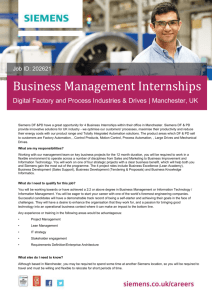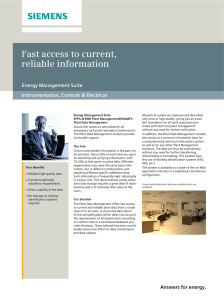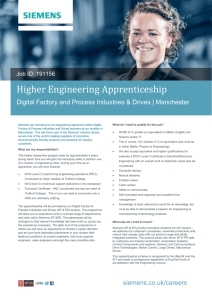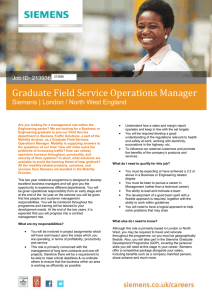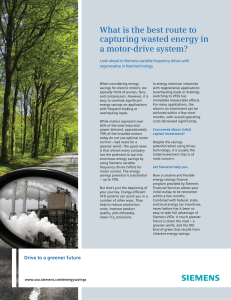Regenerative drives save energy and costs Application Notes
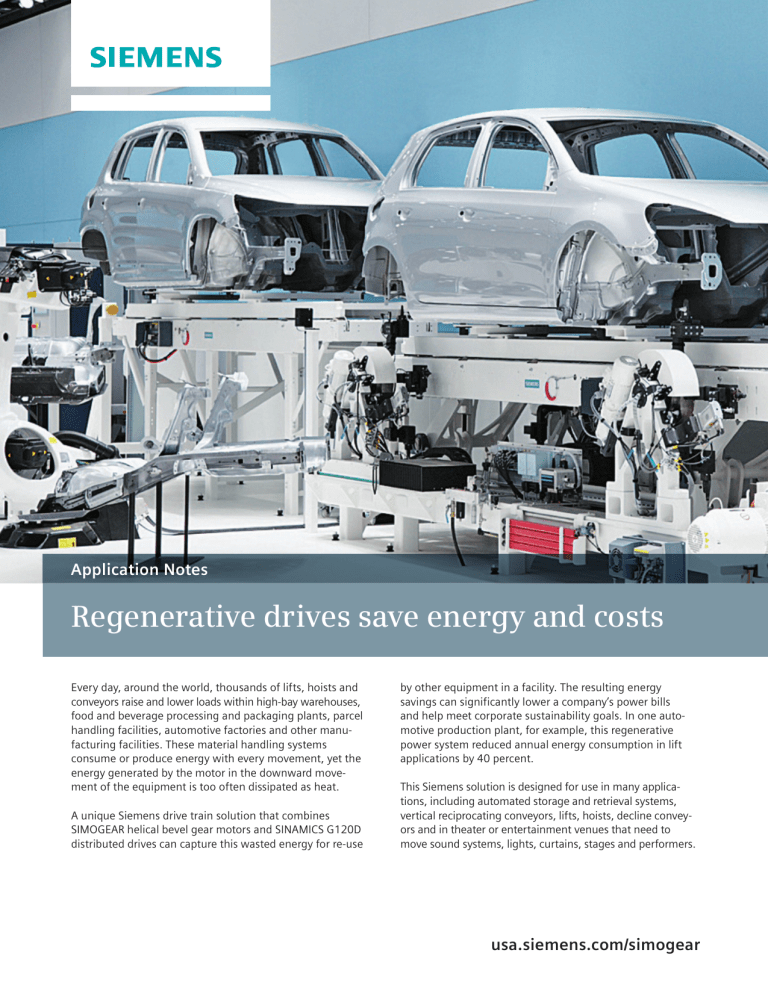
Application Notes
Regenerative drives save energy and costs
Every day, around the world, thousands of lifts, hoists and conveyors raise and lower loads within high-bay warehouses, food and beverage processing and packaging plants, parcel handling facilities, automotive factories and other manufacturing facilities. These material handling systems consume or produce energy with every movement, yet the energy generated by the motor in the downward movement of the equipment is too often dissipated as heat.
A unique Siemens drive train solution that combines
SIMOGEAR helical bevel gear motors and SINAMICS G120D distributed drives can capture this wasted energy for re-use by other equipment in a facility. The resulting energy savings can significantly lower a company’s power bills and help meet corporate sustainability goals. In one automotive production plant, for example, this regenerative power system reduced annual energy consumption in lift applications by 40 percent.
This Siemens solution is designed for use in many applications, including automated storage and retrieval systems, vertical reciprocating conveyors, lifts, hoists, decline conveyors and in theater or entertainment venues that need to move sound systems, lights, curtains, stages and performers.
usa.siemens.com/simogear
A wide range of benefits
In addition to putting energy back onto a facility’s power lines, this integrated drive system presents other benefits for machine builders and end-users alike:
■ Fewer components. This regenerative power solution
eliminates the need for the large, externally mounted brake
resistor typically required to remove the excess energy generated
by the motor during a lift’s downward movements. That’s one
less component to purchase, and one less point of potential
failure and maintenance.
■ Simplified brake management. Most variable speed drives must
send a control signal to a contactor to switch AC voltage on or
off to power the gear motor’s mechanical brake. A separate
rectifier is required to convert the AC power to DC. The G120D
drive, on the other hand, has a dedicated output that is
connected directly to the DC brake. This simplifies brake
management and eliminates two more components. Braking
parameters can also be easily changed within the drive to fit
the specific application requirements.
■ Wider range of applications. Regenerative power technology
has not been common in small drives, particularly in distributed
or decentralized architectures. This technology has typically
been reserved for large cabinet-mount drives. The G120D drive
now brings this technology to small (1-10 HP) applications.
■ Built-in position control. The G120D decentralized drive has on
board encoder evaluation for closed-loop positioning control in
a distributed layout. This simplifies control system program-
ming and management.
■ Integrated safety. SLS and SS1 functions are met within the
drive to achieve a safety integrated architecture without needing
Rectifier
Regenerative Operation
DC Link Inverter
a separate encoder and cables. This Safety Integrated approach
offers a streamlined and cost-effective way to meet safety
standards. By connecting the drive train to a PROFINET
industrial Ethernet network, equipment diagnostics can be
communicated directly to the control system or, if a Safety PLC
is used in conjunction with the drive, then safety data can pass
directly over the network using the PROFIsafe protocol.
■ Efficient, quiet gearing. Energy captured in a regenerative
system has to pass back through the entire drive train before it
reaches the power lines, which makes efficient mechanical
gearing essential to gain maximum energy savings. Helical
bevel gear technology, which is more energy-efficient than
spiroid or worm gearing, is standard in Siemens right angle
gear motors. These gear motors also operate at low noise
levels, which is important when operators work near
equipment and in entertainment applications.
The Integrated Drive System
Integrated drive trains that provide durable, energy-efficient performance with minimal maintenance are a Siemens hallmark.
Choosing from over 5,000 different possible combinations of components, Siemens engineers ensure a near perfect fit for each application’s unique requirements. These Integrated Drive
Systems help reduce operating costs by delivering longer equipment life, increased uptime, lower energy costs and extended maintenance intervals. Siemens Integrated Drive Systems also reduce project risk, complexity and overhead, since the entire drive system is engineered, assembled and delivered by one source.
SIMOGEAR
Gear Motor
Energy Flow
By using an IGBT front-end instead of the rectifier circuit found in most drives, the Siemens G120D distributed drive recovers energy generated by high-inertia loads and places it back onto the incoming line. This saves energy, simplifies the design and installation, and saves costs.
Siemens Industry, Inc.
3333 Old Milton Parkway
Alpharetta, GA 30005
1-800-241-4453 info.us@siemens.com
Subject to change without prior notice
Order No.: DTAN-00018-0314
Printed in USA
© 2014 Siemens Industry, Inc.
The information provided in this flyer contains merely general descriptions or characteristics of performance which in case of actual use do not always apply as described or which may change as a result of further development of the products. An obligation to provide the respective characteristics shall only exist if expressly agreed in the terms of contract.
All product designations may be trademarks or product names of Siemens AG or supplier companies whose use by third parties for their own purposes could violate the rights of the owners.
